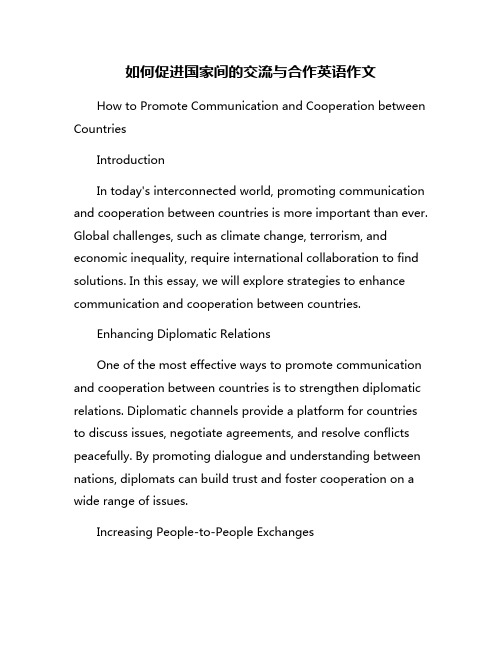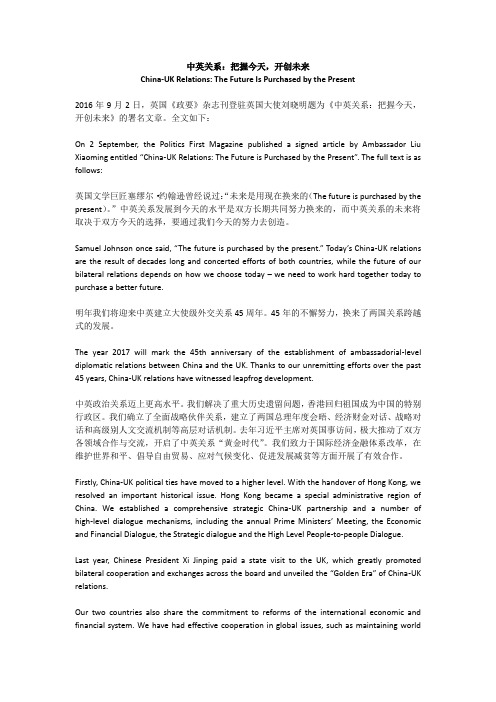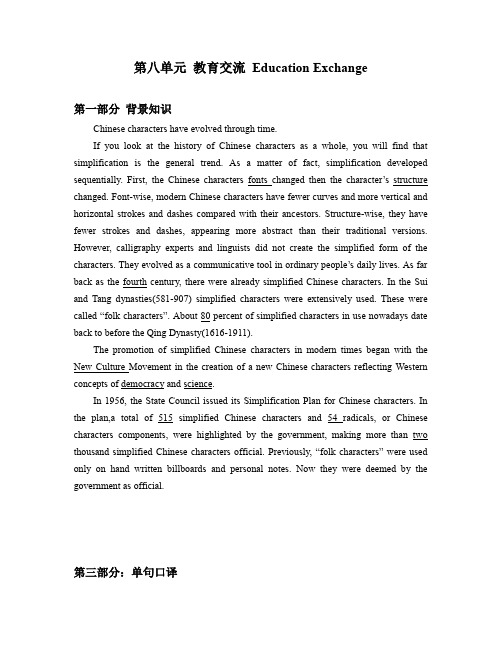Enhance Mutual Understanding between the Peoples of China and Africa for Sustainable Developme
- 格式:pdf
- 大小:818.64 KB
- 文档页数:3

英译中W e l c o m i n g S p e e c h a t a R e c e p t i o n Good evening, ladies and gentlemen, and welcome to the State Department. 女士们、先生们,晚上好,欢迎来到国务院。
Mr. Premier, I welcome you to the State Department this evening, and I think it's useful to let everybody know that you and I have one thing very much in common, even though we are just meeting for the first time, we are both geologists.总理先生,我欢迎您今晚来到国务院。
我想应该告诉大家,虽然你我二人是初次见面,但我们有一点十分相似,那就是我们都是地质工作者。
You actually went off and practiced geology. All I ever did was hiding behind the rocks during my military career.您曾身体力行从事地质工作,而我在入伍期间也曾利用岩石作掩护。
Mr. Premier, I know that the President is looking forward very much to your meeting tomorrow in the White House, where you and he will have many important issues to discuss.总理先生,我知道总统热情期待着明天在白宫与您进行会晤,并就许多重大问题与您进行磋商。

如何促进国家间的交流与合作英语作文How to Promote Communication and Cooperation between CountriesIntroductionIn today's interconnected world, promoting communication and cooperation between countries is more important than ever. Global challenges, such as climate change, terrorism, and economic inequality, require international collaboration to find solutions. In this essay, we will explore strategies to enhance communication and cooperation between countries.Enhancing Diplomatic RelationsOne of the most effective ways to promote communication and cooperation between countries is to strengthen diplomatic relations. Diplomatic channels provide a platform for countries to discuss issues, negotiate agreements, and resolve conflicts peacefully. By promoting dialogue and understanding between nations, diplomats can build trust and foster cooperation on a wide range of issues.Increasing People-to-People ExchangesPeople-to-people exchanges are another powerful tool for promoting communication and cooperation between countries. Cultural exchanges, educational programs, and collaborative projects bring together individuals from different countries to share ideas, experiences, and perspectives. These exchanges help to break down stereotypes, build friendships, and foster mutual understanding between nations.Creating Multilateral InstitutionsMultilateral institutions, such as the United Nations, the World Bank, and the World Trade Organization, play a vital role in promoting communication and cooperation between countries. These institutions provide a forum for countries to collaborate on global challenges, coordinate policies, and work towards common goals. By strengthening and supporting multilateral institutions, countries can enhance their ability to address transnational issues and promote peace and prosperity.Encouraging Economic IntegrationEconomic integration, through trade agreements, investment partnerships, and regional organizations, can also promote communication and cooperation between countries. By deepening economic ties, countries can create mutual benefits, promote prosperity, and strengthen political relationships.Economic integration can also help to build trust and reduce the risk of conflict, as countries become more interconnected and interdependent.Fostering Innovation and Technology TransferInnovation and technology transfer are essential for promoting communication and cooperation between countries. By sharing knowledge, expertise, and resources, countries can collaborate on research, development, and innovation to address shared challenges and create new opportunities. By fostering a culture of innovation and promoting technology transfer, countries can build bridges, create partnerships, and unlock the potential for new forms of cooperation.ConclusionPromoting communication and cooperation between countries is essential for addressing global challenges, promoting peace, and building a more prosperous and sustainable world. By enhancing diplomatic relations, increasing people-to-people exchanges, creating multilateral institutions, encouraging economic integration, and fostering innovation and technology transfer, countries can build stronger relationships, promote mutual understanding, and work together to solve common problems. Through collaboration and cooperation,countries can overcome barriers, bridge divides, and create a better future for all.。

中英关系:把握今天,开创未来China-UK Relations: The Future Is Purchased by the Present2016年9月2日,英国《政要》杂志刊登驻英国大使刘晓明题为《中英关系:把握今天,开创未来》的署名文章。
全文如下:On 2 September, the Politics First Magazine published a signed article by Ambassador Liu Xiaoming entitled “China-UK Relat ions: The Future is Purchased by the Present”. The full text is as follows:英国文学巨匠塞缪尔·约翰逊曾经说过:“未来是用现在换来的(The future is purchased by the present)。
”中英关系发展到今天的水平是双方长期共同努力换来的,而中英关系的未来将取决于双方今天的选择,要通过我们今天的努力去创造。
Samuel Johnson once said, “The future is purchased by the present.” Today’s China-UK relations are the result of decades long and concerted efforts of both countries, while the future of our bilateral relations depends on how we choose today – we need to work hard together today to purchase a better future.明年我们将迎来中英建立大使级外交关系45周年。
45年的不懈努力,换来了两国关系跨越式的发展。

旅游的利与弊英语作文篇一:雅思写作Task2范文:国际化旅游的利弊雅思写作Task2范文:国际化旅游的利弊现在,国际游是最大的一项产业。
但是,国际游虽然促进了不同国家人民的相互了解,更使他们的关系紧张。
这是一篇关于此论题的雅思范文。
认真研读一定的雅思范文及作文模板可以帮助我们检验自己的写作水平,并能很好地吸收和应用优秀范文里的优秀内容。
Nowadays, international tourism is the biggest industry in the world. Unfortunately, international tourism creates tension rather than understanding between people from different cultures. To what extent do you agree or disagree with this opinion?Model Answer:The growth of tourism and the numbers of people travelling to other countries for their vacations has led to debate as to whether this is beneficial. I believe that there are many problems which arise out of the tourist industry, and will examine these in detail.Many people argue that travel broadens the mind. However, this statement does not fully hold water. I would argue that spending a few weeks in another country is not long enough to gain a properunderstanding of an alien culture. A foreigner visiting Britain might be met with the traditional British reserve, and mistakenly conclude that the British are unfriendly. Furthermore, some people are unwilling to open their minds. A Western traveller to an Arab country is unlikely to consider that the veiling of women is acceptable.Being a tourist in a foreign country brings with it problems that can lead to dislike of the native people. Firstly, a foreigner is vulnerable, and is often ripped off by locals. Secondly, the language barrier can lead to misunderstandings. Thirdly, tourists are often hassled tobuy goods, which can ruin a holiday. When I went to Bali, people tried to sell me something every five minutes, and this totally spoilt my sunbathing.Local people also often end up disliking foreigners. Visitors may mistakenly act contrary to local norms, or they may just be plain offensive, as many drunken British holidaymakers must seem to the Spanish. Global tourism can lead to hostility from the native people, who may feel their traditional way of life is under threat. Additionally, the relative wealth of the foreign visitors can cause envy and resentment.In conclusion, I would say that I largely agree with the argumentthat global tourism creates misunderstanding betwe(本文来自: 千叶帆文摘:旅游的利与弊英语作文)en people from different cultures, and that the differences are often a cause for conflict rather than celebration.篇二:雅思大作文点评国际旅游利大于弊?雅思大作文点评:国际旅游利大于弊?TASK2Some people think the advantages of international tourism outweigh its disadvantages. To what extent do you agree?Recently, it is reported that tourism covers a growing proportion of gross global production, from which we can conclude that there is an increasing tendency for people to experience the joys of travel. In the circumstances, some people suppose that the benefits from international tourism are more important than its negative effects. But, I hold the opposite opinion with three reasons given in the following text(这句改成as follows是不是好一点). (66words)结构分析:这段的写法比较典型,还是受到了培训的影响,最后1句不是直接提出自己的观点,而是引出下文。

第八单元教育交流Education Exchange第一部分背景知识Chinese characters have evolved through time.If you look at the history of Chinese characters as a whole, you will find that simplification is the general trend. As a matter of fact, simplification developed sequentially. First, the Chinese characters fonts changed then the character’s structure changed. Font-wise, modern Chinese characters have fewer curves and more vertical and horizontal strokes and dashes compared with their ancestors. Structure-wise, they have fewer strokes and dashes, appearing more abstract than their traditional versions. However, calligraphy experts and linguists did not create the simplified form of the characters. They evolved as a communicative tool in ordinary people’s daily lives. As far back as the fourth century, there were already simplified Chinese characters. In the Sui and Tang dynasties(581-907) simplified characters were extensively used. These were called “folk characters”. About 80 percent of simplified characters in use nowadays date back to before the Qing Dynasty(1616-1911).The promotion of simplified Chinese characters in modern times began with the New Culture Movement in the creation of a new Chinese characters reflecting Western concepts of democracy and science.In 1956, the State Council issued its Simplification Plan for Chinese characters. In the plan,a total of 515 simplified Chinese characters and 54 radicals, or Chinese characters components, were highlighted by the government, making more than two thousand simplified Chinese characters official. Previously, “folk characters” were used only on hand written billboards and personal notes. Now they were deemed by the government as official.第三部分:单句口译对话1:对话2:。

英语写作高级词块一、under the guidance of ...under the guidance of ... 在……的指导下Under the guidance of …: Being led or directed by someone in a way that helps achieve a goal or learn something.【例句】1.Students learn best under the guidance of experienced teachers." (学生在有经验的老师指导下学习效果最好。
2.Students can improve their skills under the guidance of dedicated coaches.在敬业教练的指导下,学生可以提高自己的技能。
3.Under the guidance of their teachers, students learn about Chinese history effectively.在老师的指导下,学生有效地学习中国历史。
4.Many students thrive under the guidance of supportive mentors.许多学生在支持性导师的指导下茁壮成长。
5.Under the guidance of their parents, children develop good study habits.在父母的指导下,孩子们养成良好的学习习惯。
6.Students enjoy cultural activities under the guidance of their art teachers.学生在艺术老师的指导下享受文化活动。
7.Under the guidance of older students, new members learn the rules of the club.在学长的指导下,新成员学习社团的规则。
高中英语作文常见连贯词第一篇:高中英语作文常见连贯词高中英语作文常见连贯词表示强调的连接词still, Indeed, apparently, oddly enough, of course, after all, significantly, interestingly, also, above all, surely, certainly, undoubtedly, in any case, anyway, above all, in fact, especially.Obviously, clearly.表示比较的连接词like, similarly, likewise, in the same way, in the same manner,equally.表示对比的连接词by contrast, on the contrary, while, whereas, on the other hand, unlike, instead, but, conversely, different from, however, nevertheless, otherwise, whereas, unlike, yet, in contrast.表示列举的连接词for example, for instance, such as, take...for example.Except(for),to illustrate.表示时间的连接词later, next, then, finally, at last, eventually, meanwhile, from now on, at the same time, for the time being, in the end, immediately, in the meantime, in the meanwhile, recently, soon, now and then, during, nowadays, since, lately, as soon as, afterwards, temporarily, earlier,now, after a while.表示顺序的连接词first, second, third, then, finally, to begin with, first of all, in the first place, last, next, above all, last but not the least, first and mostimportant.表示可能的连接词presumably, probably, perhaps.用于解释的连接词in other words, in fact, as a matter of fact, that is, namely, in simplerterms.表示递进的连接词What is more, in addition, and, besides, also, furthermore, too, moreover, furthermore, as well as, additionally, again.表示让步的连接词although, after all, in spite of..., despite, even if, even though, though, admittedly, whatever may happen.表示转折的连接词however, rather than, instead of, but, yet, on the one hand, on the other hand, unfortunately.whereas;some, others;here, there;on the contrary;in contrast to;in spite of;not only...but also;while;although;nevertheless years ago...today;this...that;the former...the later;then...now;the first...whereas the second;once...now表示原因的连接词for this reason, due to, thanks to, because, because of, as, since,owing to.表示结果的连接词as a result, thus, hence, so, therefore, accordingly, consequently, asconsequence.用于总结的连接词on the whole, in conclusion, in a word, to sum up, in brief, in summary, to conclude, to summarize, in short.其他类型连接词Mostly, occasionally, currently, naturally, mainly, exactly, evidently, frankly, commonly, for this purpose, to a large extent, for most of us,in many cases, in this case第二篇:10篇常见高中英语作文(120词)作文一For a better understanding between parents and children(Generation Gap)范文一Nowadays,there is often a lack of understanding between parents and children.Children always complain that their parentsare out of date,while parents can't approve of what their children say and do.Thus,a big generation gap is formed.The gap remains wide for many reasons.Children want to be free to choose their own friends,select their own classes in school,plan their own future,earn and spend their own money,and generally run their own life in a more independent way than many parents allow.Also,young children wish to be understood by their parents,but most parents don't quite understand their children.They regard it as their responsibility to teach their offspring traditional beliefs.They want them to be obedient and do well in school.Therefore,misunderstanding often arise from parents' tendency to interfere in children's daily activities.In my opinion,most problems between parents and children could be solved by joint efforts of both sides to enhance mutual understanding.范文二Nowadays there is often a lack of understanding between parent and child.Parents often complain about their children's “unreasonable” behavior, while children usually think their parents too “old-fashioned.” Then, when a child has a problem, he usually goes to his intimate friends for sympathy and advice, leaving his parents totally in the dark.There are some possible reasons for the present situation.First, the two generations, having grown up at different times, have different likes and dislikes for the things around them and thus have little in common to talk about.Second, parents and children, due to the misunderstanding between them, may even feel it uncomfortable to sit face to face with each other talking.Finally, with the pace of modern life becoming faster and faster, both parent and child are too busy to spare enough time to exchange ideas, even if they find it necessary to communicate.As a result,the gap between them is growing wider and wider.To bridge this so-called generation gap, in my opinion, both parent and child should make an effort.The children should respect their seniors.The older generation, on the other hand, should show solicitude for the young.As for their differences, both generations should make allowance for each other.If they will take the first step by actually talking to one another, it won't be long before the arrival of a better understanding between parent and child.作文二Energy problem范文一how to solve the energy problem1.有人认为解决能源危机的方法是厉行节约。
项目整理高空项目场地项目室内模块游戏1 独木桥23 电网48 红黑商战72 暴风骤雨2 断桥24 鳄鱼潭49 乐章73 大人小人3 高空相依25 孤岛50 迷宫74 钉子游戏4 空中单杠26 罐头鞋51 啤酒游戏75 反口令5 缅甸桥27 黑暗52 团队决策76 进化论6 攀岩28 鸡蛋飞行器53 团队角色77 老鼠大象7 三人行29 交易电网54 团队帽子78 数数抱团8 天梯30 荆棘排雷其他79 撕纸游戏9 团队攀岩31 联合舰队55 Human Bingle 80 松鼠游戏10 下降32 雷阵56 搬椅子81 跳棋低空项目33 盲人绳房57斗转星移82 同生共死11 背摔34 盲阵58 风火轮83 因为所以12 求生35 魔毯59 呼啦圈84 抓手指13 相依为命36 牧羊60 画图85 杀人14 越障37 千钧一发61 画笑脸室内项目38 牵手62 口杯传递15 盲屋39 清除核废料63 连环手16 七巧板40 生死时速64 罗马炮架17 挖金矿41 十面埋伏65 毛巾传递18 驿站传书42 时空隧道66 魔法踏板19 终极魔方43 偷天陷阱67 人体多米诺20 筑塔44 移桩接水68 卧式传递水上项目45 有轨电车69 圆圈舞21 泅渡46 战争70 热身22 扎筏47 逐鹿中原71 总结独木桥独木桥项目介绍:✓学员依次攀爬上一根高约8米的独木桥,从一端走到另一端。
项目目标:✓增强自我控制与决断能力以适应不断变化的环境;✓分解、克服心理压力,建立挑战困难的自信心与勇气;✓无论后退是多么舒适,也不为舒适而后退;✓个人的成功离不开团队的支持。
Single-log BridgeBrief introduction✓All the members climb to a single-log bridge with 8 meters height, go through the bridge from one end to the other end.Objectives✓To strengthen the abilities of self-control and decision making so as to fit in with the external environment with continuous changes; ✓Overcome the great inner pressure to build up self-confidence and courage;✓No matter how comfortable it will be, never shrink from difficulties for comfort;✓One can not be success without the team’s support.断桥断桥项目介绍:✓所有成员将爬上一个8米高的断桥,从一端跳到另一端并返回。
英语论文中西方饮食文化差异AbstractWith the continuous development of globalization, cultural exchanges between the East and the West have become increasingly frequent. Food, as an important part of culture, reflects the differences between Eastern and Western cultures to a large extent. This paper aims to explore the differences in food culture between Eastern and Western countries, including the historical background, dietary habits, ingredients, cooking methods, and table manners. By examining the cultural factors behind these differences, we can gain a deeper understanding of the rich diversity and uniqueness of Eastern and Western food cultures.IntroductionFood is not only a source of nutrition but also a carrier of culture. It reflects the values, beliefs, and customs of a society. The cultural differences between Eastern and Western countries are evident in their respective food cultures. In this paper, we will examine the differences in food culture from various aspects, ranging from historical factors to table manners.A. Historical BackgroundThe development of food culture in Eastern and Western countries is closely related to their historical background. Eastern countries, such as China and Japan, have a long history of agriculture, which shapes their food culture characterized by rice as a staple food and the use of chopsticks for eating. In contrast, Western countries, such as France and Italy, have a long history of animal husbandry and the cultivation of wheat. This influencestheir food culture characterized by bread and pasta as staple foods and the use of forks and knives.B. Dietary HabitsThe dietary habits of Eastern and Western countries also differ significantly. Eastern countries emphasize balance and harmony in their meals. They believe in the concept of yin and yang, and their meals typically consist of a combination of grains, meat or fish, vegetables, and soy products. In contrast, Western countries tend to have more varied and individualistic eating patterns. They often have three main meals a day, with a focus on meat, dairy products, and a wide range of fruits and vegetables.C. IngredientsThe choice of ingredients in Eastern and Western cuisines is another area where differences can be observed. Eastern cuisines heavily rely on soy sauce, soybean oil, and various fermented products, such as miso and soybean paste. These ingredients contribute to the umami taste that is prominent in Eastern dishes. In contrast, Western cuisines commonly use butter, cream, and various cheeses to enhance flavors. Moreover, the use of herbs and spices, such as basil, thyme, and oregano, is prevalent in Western cuisines, adding depth and complexity to dishes.D. Cooking MethodsThe cooking methods employed in Eastern and Western cuisines also differ significantly. Eastern cuisines often involve stir-frying, steaming, and boiling, which are quick and efficient methods that retain the natural flavors and textures of ingredients. In contrast, Western cuisines often involvebaking, grilling, and roasting, which allow flavors to develop through caramelization and browning. Slow cooking methods, such as stewing and braising, are also commonly used in Western cuisines to tenderize meats and enhance flavors.E. Table MannersTable manners and etiquette also vary between Eastern and Western cultures. Eastern cultures, such as China and Japan, emphasize the importance of communal dining and the sharing of dishes. Meals are often served family-style, and it is considered polite to take small portions and try a bit of everything. In Western cultures, individual plates are more common, and each person's meal is often separate and portioned individually. Additionally, the use of utensils differs, where chopsticks are used in Eastern cultures and forks, knives, and spoons are used in Western cultures.ConclusionIn conclusion, the differences in food culture between Eastern and Western countries can be attributed to their historical background, dietary habits, choice of ingredients, cooking methods, and table manners. These differences reflect the values, beliefs, and customs of each culture. By understanding and appreciating these differences, we can promote cultural exchange and enhance mutual understanding between Eastern and Western societies.。